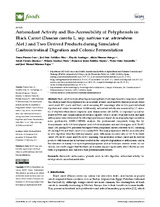Mostrar el registro sencillo del ítem
Antioxidant Activity and Bio-Accessibility of Polyphenols in Black Carrot (Daucus carota L. ssp. sativus var. atrorubens Alef.) and Two Derived Products during Simulated Gastrointestinal Digestion and Colonic Fermentation
| dc.contributor.author | Pereira-Caro, Gema | |
| dc.contributor.author | Ordóñez-Díaz, José Luis | |
| dc.contributor.author | Santiago, Elsy de | |
| dc.contributor.author | Moreno Ortega, Alicia | |
| dc.contributor.author | Cáceres-Jiménez, Salud | |
| dc.contributor.author | Sánchez-Parra, Mónica | |
| dc.contributor.author | Roldán-Guerra, Francisco Javier | |
| dc.contributor.author | Ortiz‐Somovilla, Víctor | |
| dc.contributor.author | Moreno-Rojas, José Manuel | |
| dc.date.accessioned | 2021-02-19T12:35:25Z | |
| dc.date.available | 2021-02-19T12:35:25Z | |
| dc.date.issued | 2021 | |
| dc.identifier.uri | http://hdl.handle.net/10396/21087 | |
| dc.description.abstract | Black carrot has been attracting increasing thanks to its high bioactive compound content. This study presents the polyphenol bio-accessibility of black carrot and two derived products (black carrot snack (BC snack) and black carrot seasoning (BC seasoning)) after in vitro gastrointestinal digestion and colonic fermentation. Additionally, antioxidant activity was measured by 2,2′-azinobis-(3-ethylbenzothiazoline-6-sulphonic acid) diammonium salt (ABTS), 1,1-diphenyl-2-picryl-hydrazyl (DPPH) and oxygen radical absorbance capacity (ORAC) assays. Nine flavonoids and eight anthocyanins were determined by ultra high-performance liquid chromatography high resolution mass spectrometry (UHPLC-HRMS) analysis, the predominant compounds being the hydroxycinnamic acids 3-O-feruloylquinic acid, 4-O-feruloylquinic acid and chlorogenic acid. The BC snack (108 µmol/g DW) presented the highest total polyphenol content, followed by BC seasoning (53 µmol/g DW) and black carrot (11.4 µmol/g DW). The main polyphenols still bio-accessible after in vitro digestion were the hydroxycinnamic acids, with mean recovery rates of 113 % for black carrot, 69% for BC snack and 81% for BC seasoning. The incubation of black carrot and its derived products with human faecal bacterial resulted in the complete degradation of anthocyanins and in the formation of mainly 3-(4′-hydroxyphenyl)propanoic acid as the major catabolic event. In conclusion, our results suggest that the black carrot matrix impacts significantly affects the bio-accessibility of polyphenols and, therefore, their potential health benefits. | es_ES |
| dc.format.mimetype | application/pdf | es_ES |
| dc.language.iso | eng | es_ES |
| dc.publisher | MDPI | es_ES |
| dc.rights | https://creativecommons.org/licenses/by/4.0/ | es_ES |
| dc.source | Foods 10(2), 457 (2021) | es_ES |
| dc.subject | Flavonoids | es_ES |
| dc.subject | Anthocyanins | es_ES |
| dc.subject | Phenolic acids | es_ES |
| dc.subject | In vitro digestion | es_ES |
| dc.subject | Antioxidant activity | es_ES |
| dc.subject | Derived products | es_ES |
| dc.subject | Microbial metabolites | es_ES |
| dc.title | Antioxidant Activity and Bio-Accessibility of Polyphenols in Black Carrot (Daucus carota L. ssp. sativus var. atrorubens Alef.) and Two Derived Products during Simulated Gastrointestinal Digestion and Colonic Fermentation | es_ES |
| dc.type | info:eu-repo/semantics/article | es_ES |
| dc.relation.publisherversion | http://dx.doi.org/10.3390/foods10020457 | es_ES |
| dc.relation.projectID | Junta de Andalucía. PP.AVA.AVA2019.037 | es_ES |
| dc.relation.projectID | Gobierno de España. FPU16‐05881 | es_ES |
| dc.relation.projectID | Gobierno de España. RTI2018‐096703‐J‐I00 | es_ES |
| dc.rights.accessRights | info:eu-repo/semantics/openAccess | es_ES |

